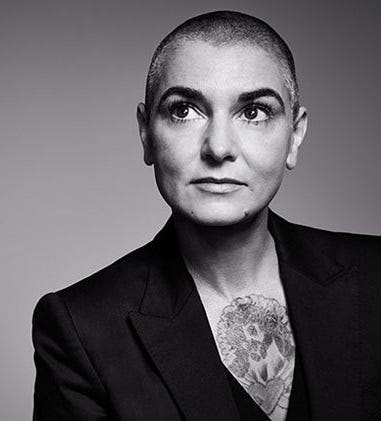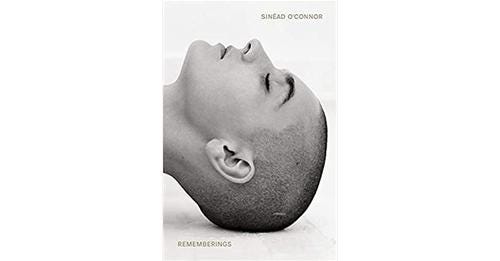Remembering(s) Sinead O'Connor
I’ve got a book recommendation for you – Sinead O’Connor’s brand new memoir, Rememberings. I’ve just finished reading it. I loved it. It’s a difficult read – it might not present the full picture you’re expecting, but at the same time I think it explains itself very well; through prescripts and postscripts O’Connor explains the protracted delivery of the book and the irony to the title – there are whole passages of her life she has lost. But what you do get is a whole lot of heart. Huge gumption. A soul-stirring war-cry against the absurdity of the way her mental health was minimized to tabloid headline-fodder.
And yet, Sinead never ever feels too sorry for herself.
The media has forever treated her like shit. A punching bag for bad gags about craziness.
It’s sexism.
Rock ‘n’ Roll has been accepting loons since back to the late 1950s. But only if they were male. They mostly were you see, so that was okay. Keith Richards is allowed to have a drug problem because he’s Keef, man. The Human Riff. Eccentric, wild behaviour is actually just another white male privilege.
Sinead O’Connor has a voice in a million and a catalogue to match. She is one of music’s true greats in my book. I’ve been under her spell since I first heard her. I remember seeing a live show on TV late at ight and I was transfixed – nearly frightened at times by the intensity. But I still remember feeling so different about it – as she sang Feel So Different. I had never heard anything like it. And I was in love with the sound. This carried on across her first four albums and an EP – a perfect catalogue at that point. And look, after, there were some speed wobbles, the production didn’t always match the song, the songs didn’t measure up 100% of the time – but the risks and range were incredible. Traditional Irish music, reggae, covers of rock, pop and jazz songs, standards recast, protest tunes, and such strength of musical character throughout. Such vulnerability. And then dozens and dozens of cameos and collaborations. Hear Sinead – and you’ll always pick her voice – with Massive Attack and Moby, with Afro Celt Soundsystem and The The. Hear her singing Guide Me God with Ghostland and it’s as good as anything – anything – from her solo catalogue. Amazing. Songs with U2 and Willie Nelson and Peter Gabriel. Songs with lesser-known artists too. A gun for hire. Always loaded, if you’ll pardon the pun.
The way the media told the story Sinead O’Connor’s high point was having a number one hit with the Prince-penned Nothing Compares 2 U. The slide happened after she tore up a photo of the Pope on Saturday Night Live.
Perhaps the genius-stroke in this book is the way that script is flipped. To hear Sinead tell her story – for it is HER Story – the low point was selling to number one and becoming public property. The high point was tearing up that photo of the Pope on live TV and setting herself free.
Now, however you view that the story behind the story is fascinating. O’Connor’s trauma runs deep and her mother – unstable and incapable of looking after anyone, least of all herself – died when Sinead was 18. The tear in the video and the shake in the voice when she sings “All the flowers that you planted, mama, in the back yard, all died when you went away” is borne of her real and lived experience. As she says at some point in the book and more than once in interviews, Prince might have written the song, but she owns it. She sings this song forever and thinks always of her mother, doing her best to remember her in a good light.
When her mother died she took down the only photo that was on the wall. A picture of the Pope. She carried it with her knowing that one day there’d be a time for its destruction. She was of course crucified for her actions – but she was ahead of her time. It would take another decade for the Pope of the time to actually acknowledge the systemic sexual abuse and cover-ups in the Catholic church. A further two decades have passed and the corruption continues. So does the mocking of O’Connor’s mental state.
In the book she can’t remember a lot after she set herself free and waved goodbye to being a pop star. The heavy, habitual marijuana smoking – her ‘medicine’ – has seen to that. In her mid-50s now she has only just kicked the habit. And like anyone kicking a habit, she lives in hope the kick will last longer than the habit did.
But if this all sounds intense – well, it is. But the book is also funny. Particularly as O’Connor is filter-less and so she shits on Prince – calls him a jerk, and a bully. Between the lines we see another example of how the press enjoyed calling Prince crazy but only in the best possible way, whereas Sinead was just dumb-crazy, silly-crazy, Crazy-crazy!
Anthony Keidis of the Red Hot Chili Peppers wrote a tell-all many years ago. And people seemed to love it. In those pages, he talked of his love affair with O’Connor. But she reckons it was only ever in his dreams. She’s happy to admit to an affair with Peter Gabriel though. Damning herself as nothing more than “weekend pussy” – and eventually deciding she needed to value herself a bit more than that. More hints of the results from carrying baggage, from trauma. But some blunt self-effacing humour in and around that.
She has four children. But the story isn’t ever of a working mother. It’s of an unstable person that had four children and isn’t with any of their fathers. Why is that anyone else’s business? And why is she unstable? It’s not because she had children to different men. I was reminded – several times – reading this book of how far we’ve come in our sympathy for situations, in our attempts at empathy. But also, of how far we still need to travel too.
I loved this book – because I love Sinead O’Connor’s music. I loved this book because I loved the way she kicked back in its pages. But there’s a sadness here too – she has shelved herself, she is a shell of what she once was and what she might have been. But that shell is still here. And still her. And on more than one occasion she gave it a go to remove everything – even the shell. To not be here at all. She lives. She breathes. Her struggle is real. And she continues to fight.
You can read her book this weekend – it will fly by. And if you do – or even if you don’t I’ve made a playlist of some of her finest musical moments.
A few years ago, when O’Connor celebrated her 50th birthday and the press was having yet another go at picking on her I wrote this piece – in recognition of her brilliance, in support of her talent, in the hope that people might remember her genius.
Now, O’Connor is having a go at reminding people of her place in the culture. And she deserves to be heard. In all senses.
Here’s a great piece about her and the book from The New York Times.
I really believe that no one compares 2 her.
And of course I’ve got your back with another (Sinead-less) playlist – here’s your 17th volume of A Little Something For The Weekend.








